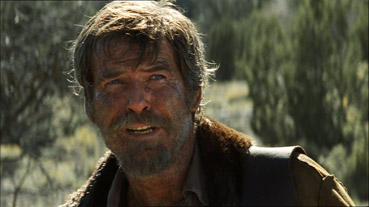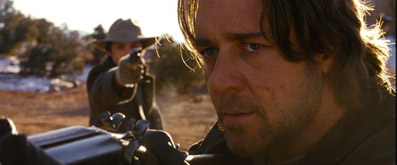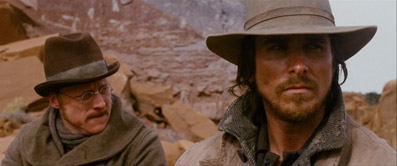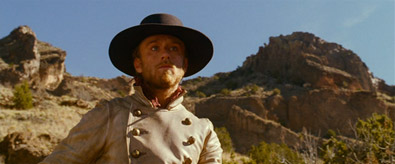|
With the release of The Assassination of Jesse James By The Coward Robert Ford on DVD, and with it the completion of a western genre resurgence, I thought it fitting to take a retrospective look at two releases that began the recent trend – Seraphim Falls, which had a Christmas DVD release, and the remake of 3:10 To Yuma that came out to buy in the UK at the end of January.
Both these films had a much needed positive effect on audiences after a long drought of respectable westerns that had left audiences disillusioned with the genre. Since a flurry of success in the 1990's with such films as Sam Raimi's The Quick and the Dead and arguably the best western of the last 15 years, Clint Eastwood's Unforgiven, there has not been much to get excited about on the subject. Some might say the western is an outdated paradigm to explore contemporary concerns and the youth of America having not grown up with this genre will therefore not allow it into their zeitgeist, but now that argument has been largely disproved. We can thank U.S. television for putting the western back into the collective consciousness of the cool with Deadwood, a gritty wild west series that ignited the touch paper in 2004 for the explosion that has reached its peak with Andrew Dominik's Jesse James tale, starring Brad Pitt.
Before I go on to take a closer look at the two films that are the focus of this article I must mention a fantastic film that although helped in the resurgence has been overlooked far too much. The film in question is an Australian western, directed by John Hillicoat and written by the lyrical genius Nick Cave – The Proposition, released in 2006. Transposing the American frontier themes and iconography to the very similar colonialisation of Australia by the British at the same period, The Proposition reinvented the genre cannily, yet retained the elements strongly distinguishable as western. I advise anyone interested enough in this subject to continue reading to pick up a copy of The Proposition if you have not already done so!
Anyway, without further digression I will begin on the first review of the duo.
Seraphim Falls is unique to most of the other films mentioned in this article due to its original narrative – it is not a remake or based on a well known legend. Essentially a chase film, the pace of Seraphim Falls is pretty relentless in contrast to many broodingly epic pieces of the genre where the action unfolds at a slower pace, although this is broken up by more measured scenes. The themes and performances are no less epic than a classic, with both Liam Neeson and Pierce Brosnan playing the duel leads with great assurance. Never really a fan of Brosnan's acting work, it was he who impressed me most with a raw, stripped down and affective performance, making his character of ex-soldier Gideon as ambiguous emotionally as the unfolding narrative. Neeson was more than a match for this, his character Carver's hot footed and determined pursuit of Gideon asserts and confirms Brosnan's desperation of escape.

The actors would be left floundering though if it was not for masterful writing and direction from first time full length feature filmmaker David Von Ancken. As a name unknown to me, I must confess I entered into watching the film with a cynicism mainly fuelled by this lack of knowledge. It can be difficult for seasoned well-knowns to successfully climb the mountain of genre, so I was dubious of this newcomer's competence. But obviously Ancken has done his homework. What is most impressive is the courage taken in this film to go out on a limb and try to create a new western legend apart from many of the conventions that have helped filmmakers in the past. It has an original screenplay that backs away from much of the tired and historically inaccurate iconography of the genre in favour of a straightforward chase narrative with a slow reveal into the main characters' identities shown in periodical flashbacks. Despite its setting it is very much a modern movie, but not in a negative sense, and in keeping a spurred foot in the Wild West while placing the other firmly in the present is what can make a great western. The unavoidable parallels between the disillusioned ex-soldiers of the Civil War featured in the film and the unrest caused by recent events in the Middle East is forever burning in the mounting flashback sequences, delivering a fitting reflection of the time when we see how Gideon and Carver came to be embroiled in the cat and mouse game.
In the gritty and no-nonsense attitude, Seraphim Falls owes more to Sam Peckinpah than John Ford or Sergio Leone. It is arguable that in this age any western worth more than a mainstream potboiler must be authentic enough to have more in common with The Wild Bunch than The Searchers – I personally believe this to be true, and thankfully both the films focal to this article are of that type. This is not to say the epic and mythic qualities of many good films of this type are absent in Seraphim Falls, the landscape fits into the paradigm if the genre – it is a character in itself, the amount of ground covered in the chase creates some beautiful natural atmospheric changes in the mise-en-scene, beginning on a snow topped mountain and ending on a desert plain.
But it is the realism anchoring much of the movie that makes the departure into a more symbolic surrealism later in the film all the more noticeable. It is this late sequence featuring an inspired cameo by Anjelica Huston that intertwines the grit of the first two acts with something more recognizable as mythic or even supernatural, giving a gravity to the final scene that leaves the realism behind and combines the drama of the characters fate with the grandeur of a classic landscape motif.
After watching Seraphim Falls I was left having my western thirst quenched but finally without my intelligence being insulted.
| sound and vision (Seraphim Falls) |
|
A spotless and finely detailed 1.78:1 anamorphic transfer, typical of the standards expected from the modern Hollywood product. The film makes expressionistic use of colour in a manner that has become almost standard operating procedure for historical dramas in the digital age, with naturalistic colour stripped back in favour of blue hues for cold exteriors, warmer browns for interiors and snow-free landscapes and golden hues for summer fields, all of which have been captured effectively.

Three soundtracks are offered, the Dolby 2.0 stereo track outclassed by the Dolby and DTS 5.1 surround tracks, both of which do well on location effects (waterfalls, wind, raging rivers, etc.), and have a fine clarity and range. Music sounds particularly good. The DTS track has the edge in volume.
Optional subtitles for the hearing impaired are also included.
| extra features (Seraphim Falls) |
|
The audio commentary with Pierce Brosnan, director/writer David Von Ancken and production designer Michael Hanan is a good one, with all parties talking articulately about various aspects of the film. It is interesting to hear the first-time director talk about his experiences on a feature film set, although it is clear he is familiar with directing large productions for television. Brosnan's ego, try as he might to tame it, does provide the commentary with more than enough on how Pierce felt during the shoot. I can't be too hard on the guy though as this is the best role I've seen him in, well, maybe ever!
The behind the scenes documentary (18:48) did what many of these filmed-for-DVD features do and mirrored much of what is said on the commentary track. However, there is on-set footage that shows first hand how nasty the terrain and weather must have been to shoot in, and some choice words from Liam Neeson, who does not appear on the commentary.
That's pretty much it, save an Icon trailer reel which is hardly going to get anyone excited, unless you are some bizarre trailer-loving freak (sorry to trailer lovers).
Now, as some of the general public and any self respecting western fan should know, 3:10 to Yuma circa 2007 is a remake of a film of the same name made in 1957. This knowledge alone can send many discerning cinephiles running from the prairie, and I was obviously dubious myself. I confess to not having much knowledge of the original on the release of James Mangold's new version, but have since done my homework. The 1957 film is a solid and well made movie, with a strong writer (Elmore Leonard) at it's foundation, but it lacked anything to make it truly classic. Its director Delmer Daves was a genre veteran, but not in the same league as Ford or Hawkes.

The director of the remake, James Mangold is a fan of the original, and it was largely down to him that the film got made at all. What he wanted to do was create a more in-depth and real portrayal of the two key characters as well as focus on the long journey to the train station that develops their bond that is not present in the first film. So far, so non-corporate minded indeed. So, I was glad to not be let down by the finished product. Mangold's film is a lovingly crafted and beautifully acted morality play with aspirations to the stature of Leone yet the grit and grime of Peckinpah. It is possibly a more accomplished, yet slightly more sentimental film than Seraphim Falls, with much of this assuredness due to the experience of the director (Mangold has directed, amongst others, Identity and Walk The Line). I am in no doubt of Von Ancken's passion for the genre or talent as a filmmaker, but Mangold creates a more complete world where you can almost smell the dust and sulphur. This is accentuated by a once soaring and anthemic then beautifully subtle score by Marco Beltrami, with more than a touch of Ennio Morricone's immortal spaghetti western scores.
In this version of Leonard's story we see the peg-legged rancher Dan Evans (Christian Bale) fighting to keep his land from being demolished to make way for the Trans Continental Railroad as well as struggling to earn the respect of his family. After stumbling upon coach-robbing outlaw Ben Wade (Russell Crowe) and his gang, an opportunity presents itself after Wade is captured by the law whereby Evans can keep the railroad at bay. After informing the posse of lawmen that he fought in the Civil War as a sharpshooter, he becomes a guard to ensure the criminal's safe passage to a jail train in Contention without Wade's gang staging a successful rescue (now fronted by Wade's number two, the ruthless Charlie Prince played wonderfully by Ben Foster).
Where Seraphim Falls takes place with the two main characters geographically apart for most of the film, much of 3:10 To Yuma's narrative is built around the close interaction between these two characters, and Mangold has two modern greats cast to cultivate the required chemistry. They are more than up to the challenge, and both men embody their roles perfectly, both when together on screen or sharing scenes with members of the accomplished supporting cast (most notably Foster and Peter Fonda as a grizzled bounty hunter). Between them Bale and Crowe monopolise every scene, so the film rests on the gravity of their screen presence, and they bring the characters to life with the subtlety of the trademark western male. Crowe's Ben Wade has a charm and humour to him that endears him to the audience despite his actions. A wry smile here and a drawling quip there creates this lighter side, whereas props such as his gun with a crucifix on it's handle and a sketchbook he takes out in calmer moments show a serious side of religion and creativity. It is interesting to observe what is connoted in these props; Christianity is shown as a part of a weapon, a destructive force whereas the sketchbook shows the opposite, an ability to create. These are just a couple of the many intelligent updates Mangold and writers Derek Haas and Michael Brandt made in the remake that builds on and reinforces Leonard's original story.

Bale's Dan Evans is a more complete character than Van Heflin's portrayal in the original movie, down to accomplished acting and Mangold's idea of giving him a physical disability to mirror his mental state. The narrative thrust is shifted to focus more on the aforementioned journey to Contention, this once again makes physical the emotional, as the story is about the metaphorical journey of the two men as they become close in spite of their moral differences. This is a common theme that has been explored tirelessly – recently in the 1980's, movies outside the genre such as Midnight Run and 48 Hours have playfully subverted the idea for dramatic and comedic purposes.
As a classical and serious morality exploration with a more epic and grandiose feel to it than Seraphim Falls, 3:10 To Yuma can be forgiven for it's basic lack of originality in the fact that it takes both the Elmore Leonard story and the original motion picture and uses them as a basis to update and reinvigorate a strong and basic tale. The allusions to Iraq are as present here as with Seraphim Falls, but there is a more basic and human battle that is fought in this film that needs no referential knowledge of past or present.
The religious symbolism that comes through the dust and dirt seems more a vehicle to explore basic human struggles than trite or preachy; the deeply religious man is a ruthless killer, but the guy just trying to provide for his family seems devoid of any faith. You just have to look at another well remade film – Martin Scorsese's Cape Fear – to see a familiar example of this theme outside of the western.
It is clear that James Mangold has borrowed from other sources than the film he remade, and that is to his credit, breathing something fresh into an ailing genre. David Von Ancken did something similar with his film also, yet 3:10 To Yuma does benefit from having a ready-made foundation. Personally I find it difficult to pick a favourite, as I think both films are as accomplished in different ways, but what I am certain of is how both have risen the bar for an American genre that was in need of a kick up the ass!
| sound and vision (3:10 to Yuma) |
|
A very strong 2.40:1 anamorphic transfer with excellent detail and contrast. Digital colour timing is once again evident, the inevitable period hues interestingly augmented by knocking back some colours and enhancing others (green and blue of trees and plants, the orange glow of oil lamps and fires, blue skies, and so forth). Effective in itself, it can make flesh tones look a just a shade unnatural at times.

There's a choice between Dolby 5.1 surround and Dolby Surround EX and there's not a whole lot to choose between them. The use of the surrounds is more low key than on Seraphim Falls but are still effectively employed for directional effects and location atmospherics.
Optional subtitles for the hard of hearing are included.
| extra features (3:10 to Yuma) |
|
The audio commentary with director James Mangold is a detailed and zealous feature, the filmmaker filling the time well with explanations of technique, narrative and his take on the genre. I have listened to his commentaries before and have always been impressed with their engaging and passionately concise accounts – he reminds me of a good film studies teacher in his mannerisms.
There is also a set of featurettes that could have been one long documentary. Destination Yuma (20:05) sees the cast and crew on location and features interviews from director to costume designer on various sets. There is a detailed breakdown of the shooting of Wade's gang taking down a Pinkereton coach near the beginning of the film as well as showing the usage of props such as a mock rubber version of an early Gatling gun.
Outlaws, Gangs & Posses (12:22) has American Historians document the true Wild West and fascinatingly dispel myths about outlaws. For example the famous gunfight at the OK Corral was 'less of a gun fight, more of an execution' by Wyatt Earp and his gang, plus the timidity of the townsfolk of the time is apparently as much of a myth as the exaggerated stories of outlaw behaviour.
Out of all the extras on the DVD I found the next featurette the most surprisingly intriguing, as it does not directly discuss the film itself but is a historical piece about the time. An Epic Explored (6:07) includes factual information as well as Mangold giving his perspective of the western as fantasy and myth, denying that a decent film of the genre should focus too heavily on period accuracy. He also remarks on the connections with sci-fi the western genre has in their shared ability to tackle subtext and socio-political metaphor.
|